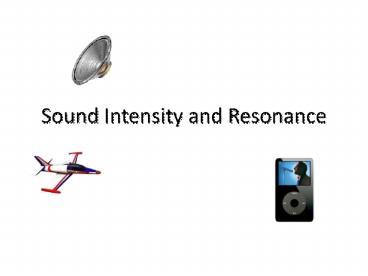Sound Intensity and Resonance - PowerPoint PPT Presentation
Title:
Sound Intensity and Resonance
Description:
Sound Intensity and Resonance Intensity Intensity is the rate at which energy flows through a unit of area perpendicular to the direction of wave motion Intensity ... – PowerPoint PPT presentation
Number of Views:304
Avg rating:3.0/5.0
Title: Sound Intensity and Resonance
1
Sound Intensity and Resonance
2
Intensity
- Intensity is the rate at which energy flows
through a unit of area perpendicular to the
direction of wave motion - Intensity Power/ Area
- Area of a spherical wave 4pr2
3
Thresholds
- Intensity and frequency determine which sounds
are audible - As you have learned, humans can hear 20-20,000
Hz. - The softest sound a human can hear is at a
frequency of 1000Hz and an intensity of 1x10-12
and is called the threshold of hearing. - The loudest sound a human can tolerate has an
intensity of 1 and is known as the threshold of
pain
4
Intensity Continued
- Relative intensity is measured in decibels
- The intensity of a wave determines the loudness.
- Relative intensity is the human perception of
loudness - A difference in 10db means the sound is twice as
loud
5
Guitars
- When an isolated guitar string is held tight and
plucked, hardly any sound is heard. - When the same string is placed on a guitar and
plucked, the intensity of the sound increases
dramatically. This is called forced resonance. - The vibrating of the strings of a guitar force
the bridge of the guitar to vibrate - The forced vibrations are called sympathetic
vibrations.
6
Resonance
- All objects have natural frequencies
- Every object will vibrate at a certain frequency
- Resonance- a condition that exists when the
frequency of a force applied to a system matches
the natural frequency of vibration of the system.
7
Resonance Demos
- Go to the following link to watch a resonance
demo by Paul Hewitt - http//www.freesciencevideo.com/conceptual-physics
-demo-of-resonance.html
8
Examples of Resonance
- Example 1- Tacoma narrows bridge. The wind
blowing through the canyon watched the natural
frequency of the bridge and caused the bridge to
oscillate and eventually crumble
9
Examples of Resonance
- Example 2- A kid on a swing, pumps their legs at
the same frequency each time to cause them to
swing higher each time. They are matching the
natural frequency of the string.
10
Examples of Resonance
- Example 3- A wine glass has a natural frequency.
A singer can sing at the same frequency and can
cause the glass to vibrate until it shatters
11
Harmonics
- The fundamental frequency is the lowest possible
frequency of a standing wave. - The series of frequencies of a standing wave are
called the harmonic series - Frequency harmonic number x (speed/2 length)
- F n(v/2L)
12
Guitars Continued
- When a guitar player presses down on a guitar
string at any point, that point becomes a node
and only a portion of the string vibrates - As a result, a single string can be used to
create a variety of fundamental frequencies - L in the previous equation would represent the
portion of the string that was vibrating
13
Standing Waves in a Pipe
- Standing waves can also be set up in a tube of
air and not just on a string. - Harmonic series of a pipe if both ends are open
is different on a pipe if only one end is open - Both ends open
- Frequency harmonic number x (speed/2L)
- One end is closed
- Frequency harmonic number x (speed/4L)
14
Music
- In music, the mixture of harmonics that produces
the characteristic sound of an instrument is
referred to as the spectrum of sound, which
results in a response in the listener called
sound quality or timbre.
15
Interference
- When two waves of the same frequency interact,
you get either constructive or destructive
interference - If the waves are opposite each other they are set
to be out of phase and destructive interference
occurs. No sound is heard. - IF waves match up it is in phase and constructive
interference occurs. The sound gets louder - However, if waves with slightly different
frequencies interact, a variation creates a soft
to loud sound called a beat.































